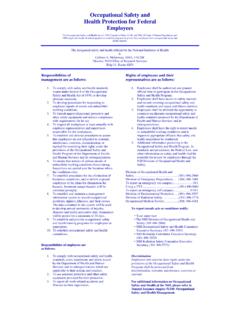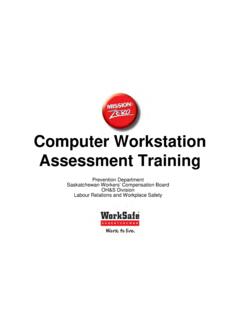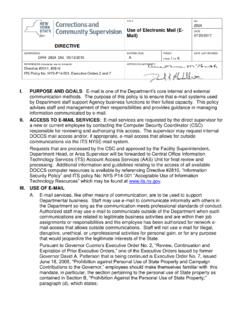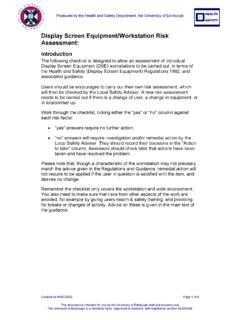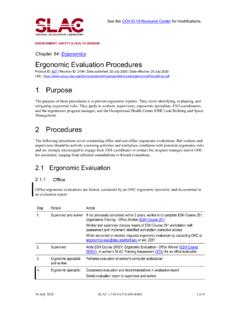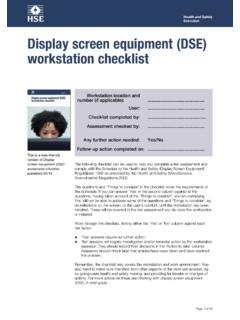Transcription of National Institutes of Health Ergonomics Program
1 National Institutes of Health Ergonomics Program 2018 Authored by the Division of Occupational Health and Safety (DOHS) Ergonomics Program Manager (EPM). 2 CONTENTS INTRODUCTION ..3 SCOPE ..3 IDENTIFICATION OF ERGONOMIC EVALUATION & CONTROL OF ERGONOMIC MEDICAL Program ACRONYMS CC Clinical Center DOHS Division of Occupational Health and Safety EPM Ergonomics Program Manager IC Institute or Center NIH The National Institutes of Health NIH-CWEH - computer workstation Ergonomics Handout NIH-EP - Ergonomics Program OEEC Office Ergonomic Evaluation Checklist OMS Occupational Medical Service OMS-HCP - Health Care Provider OMS-PT -Physical Therapist SOSB
2 Safety Operations Support Branch SOHSs Safety and Occupational Health Specialists TAB Technical Assistance Branch TAB-IH -Industrial Hygienist WMSDs Work-Related Musculoskeletal Disorders 3 I. Introduction The National Institutes of Health s (NIH) Division of Occupational Health and Safety (DOHS) strives to provide safe workplaces for the NIH community. From administrative personnel to research personnel, Ergonomics plays an important role in preventing injury and illness. The NIH- Ergonomics Program (NIH-EP) is an integral part of the NIH Occupational Safety and Health Program that uses a comprehensive approach to inform employees of the possible ergonomic hazards in their workplaces.
3 The NIH-EP establishes procedures for ergonomic hazard identification, evaluation and control, training , medical support, Program management, and Program evaluation. II. Scope The Division of Occupational Health and Safety (DOHS) develops and administers the NIH-EP for all NIH employees at risk for developing work-related musculoskeletal disorders (WMSDs). This Program focuses on employees whose primary work-related tasks require repetitive motions, awkward postures, high repetition, and forceful exertions.
4 At NIH, these types of job tasks are normally performed by personnel spending a large proportion of their day at computer workstations; personnel involved with pipetting and microscopy; personnel involved with animal care and use; personnel assisting patients; and personnel involved with repetitive or heavy lifting. III. Policy DOHS provides, at no cost to the employee, ergonomic assessments of workstations, training that identifies ergonomic hazards encountered in NIH workplaces, and medical management for employees who sustain WMSDs.
5 Following an ergonomic assessment of a workstation , DOHS issues a written evaluation that identifies potential ergonomic Health hazards and suggests changes in practices, procedures, and equipment that may further reduce the risk of WMSDs. Supervisors are responsible for determining what equipment purchases are feasible. Individuals with existing disabilities or medical conditions should follow their Institute or Center s (IC s) procedures for requesting a reasonable accommodation in accordance with the NIH Policy Manual Chapter 2204 Reasonable Accommodations.
6 IV. Definitions Ergonomics : The science of fitting jobs to people. Ergonomics encompasses the body of knowledge about physical abilities and limitations as well as other human characteristics that are relevant to job design. Musculoskeletal Disorder (MSD): Any injury or illness related to the musculoskeletal system which involves the nerves, tendons, muscles, and supporting structures such as the intervertebral disc. The injury or illness is usually caused by repetitive motions, awkward postures, high 4 repetition, and/or forceful exertions.
7 Work-Related MSD: A MSD is considered work-related when work activities or workplace conditions likely caused or contributed to a reported MSD. V. Responsibilities Ergonomics Program Manager (EPM): The EPM develops and administers the NIH-EP, coordinates and schedules ergonomic evaluations, coordinates ergonomic training sessions, regularly updates the NIH ergonomic website, maintains a database on employees who have completed ergonomic training , and remains abreast of technical issues related to Ergonomics .
8 The EPM periodically reviews and evaluates the effectiveness of the NIH-EP (Section X: Program Evaluation). Technical Assistance Branch-Industrial Hygienist (TAB-IH): The TAB-IH s responsibilities include performing ergonomic evaluations and conducting related training sessions. The TAB-IH completes an Office Ergonomic Evaluation Checklist (OEEC) for each evaluation performed for an NIH employee and sends the evaluation to the EPM. In addition, the TAB-IH compiles a list of all employees who participate in an Ergonomics training session and submits the list to the EPM.
9 Safety and Occupational Health Specialist (SOHSs): IC SOHSs conduct routine walk-through surveys in their areas of responsibility and notify the EPM of any workplace conditions or work activities that cause or are reasonably likely to cause or contribute to a WMSD. They also remind employees of their duty to report all work-related injuries and suspected illnesses to OMS. Occupational Medical Service - Health Care Provider (OMS-HCP): OMS-HCPs record all employee reports of work-related injuries and illnesses, including WMSDs, in an electronic database.
10 OMS-HCPs offer medical evaluation and treatment for WSMDs. The care consists of clinical evaluations, limited diagnostic tests, and medical care, including onsite physical therapy and acupuncture, as clinically warranted. OMS - Physical Therapist (OMS-PT): In addition to providing clinical care for employees with WMSDs, the OMS-PT provides consultative support for Clinical Center (CC) management, ergonomic assessments for injuries that occur in the CC, and relevant training for CC personnel.
